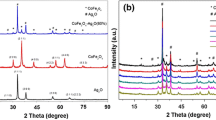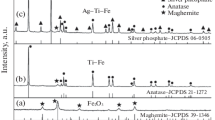Abstract
Visible-light-driven magnetic heterojunction as a promising photocatalysts has received much attention in environmental remediation. In this work, novel Z-scheme heterojunction MnZnFe2O4@Ag3PO4 (MZFO@APO) magnetic photocatalysts with excellent visible-light-driven photocatalytic activity are successfully constructed and characterized. The photocatalytic activity for phenol degradation is measured, and photodegradation mechanism is investigated with EPR, radical trapping experiments, and LC–MS. It turns out that the heterojunction introduced MZFO exhibits good adsorption effect on visible light and the direct Z-scheme bandgap alignment of MZFO and APO significantly improves charge separation and electron transfer, outperforming that of pure APO. MZFO@APO-40% with 40% APO content shows the rapid photodegradation performance, obtaining a 100% removal efficiency of phenol (25 mg L−1) after 12-min visible light irradiation, and its kinetic constants are approximately 25.3 and 4.9 times higher than that of P25 TiO2 and pure APO, respectively. Especially, MZFO@APO-40% also possesses a high magnetic separation property and can be efficiently reused for 5 cycles. Additionally, EPR and radical trapping experiments confirm that h+, O2−, and 1O2 are the main active species in the photocatalytic process. Hydroquinone and small molecular organic acids such as maleic acid and oxalic acid are detected by LC–MS, which further indicates that the pathway of phenol degradation involves hydroxylation, open-ring reactions, and mineralization reactions. The novel addition of MZFO in photocatalyst construction has the potential to promote its application in environmental remediation.








Similar content being viewed by others
Data availability
Not applicable.
References
Abraham T, Priyanka RN, Joseph S, Chacko AR, Plathanam NJ, Mathew B (2021) Fabrication of zirconium ferrite doped Ag3PO4 composite for the degradation of refractory pollutants: visible light assisted Z-scheme insight. Mat Sci Semicon Proc 130:105797. https://doi.org/10.1016/j.mssp.2021.105797
Agbe H, Sarkar DK, Chen XG (2021) Electrochemically synthesized silver phosphate coating on anodized aluminum with superior antibacterial properties. Surf Coat Technol 428:127892. https://doi.org/10.1016/j.surfcoat.2021.127892
Bortolotto V, Djellabi R, Giordana A, Cerrato G, Michele AD, Bianchi CL (2022) Photocatalytic behaviour of Ag3PO4, Fe3O4 and Ag3PO4/Fe3O4 heterojunction towards the removal of organic pollutants and Cr(VI) from water: efficiency and light-corrosion deactivation. Inorg Chem Commun 141:109516. https://doi.org/10.1016/j.inoche.2022.109516
Dai Y, Wang Y, Zuo G, Kong J, Guo Y, Sun C, Xian Q (2022) Photodegradation of acenaphthylene over plasmonic Ag/Ag3PO4 nanopolyhedrons synthesized via in-situ reduction. Appl Surf Sci 572:151421. https://doi.org/10.1016/j.apsusc.2021.151421
Deng B, Li Y, Tan W, Wang Z, Yu Z, Xing S, Lin H, Zhang H (2018) Degradation of bisphenol A by electro-enhanced heterogeneous activation of peroxydisulfate using Mn-Zn ferrite from spent alkaline Zn-Mn batteries. Chemosphere 204:178–185. https://doi.org/10.1016/j.chemosphere.2018.03.194
Du C, Song J, Tan S, Yang L, Yu G, Chen H, Zhou L, Zhang Z, Zhang Y, Su Y, Wen X, Wang S (2021) Facile synthesis of Z-scheme ZnO/Ag/Ag3PO4 composite photocatalysts with enhanced performance for the degradation of ciprofloxacin. Mater Chem Phys 260:124136. https://doi.org/10.1016/j.matchemphys.2020.124136
Feng S, Du H, Xie T, Xu L, Wang Y (2019) Preparation and photocatalytic activity of BiOI/MnxZn1-xFe2O4 magnetic photocatalyst. Ceram Int 45:10468–10474. https://doi.org/10.1016/j.ceramint.2019.02.108
Gallegos MV, Peluso MA, Finocchio E, Thomas HJ, Busca G, Sambeth JE (2017) Removal of VOCs by catalytic process. A study of MnZnO composites synthesized from waste alkaline and Zn/C batteries. Chem Eng J 313:1099–1111. https://doi.org/10.1016/j.cej.2016.11.001
Gong G, Liu Y, Mao B, Tan L, Yang Y, Shi W (2017) Ag doping of Zn-In-S quantum dots for photocatalytic hydrogen evolution: simultaneous bandgap narrowing and carrier lifetime elongation. Appl Catal B 216:11–19. https://doi.org/10.1016/j.apcatb.2017.05.050
Guo X, Liu Y, Yang Y, Mu Z, Wang Y, Zhang S, Wang S, Hu Y, Liu Z (2021) Effective visible-light excited charge separation in all-solid-state Ag bridged BiVO4/ZnIn2S4 core-shell structure Z-scheme nanocomposites for boosting photocatalytic organics degradation. J Alloy Compd 887:161389. https://doi.org/10.1016/j.jallcom.2021.161389
Habibi-Yangjeh A, Pirhashemi M, Ghosh S (2020) ZnO/ZnBi2O4 nanocomposites with p-n heterojunction as durable visible-light-activated photocatalysts for efficient removal of organic pollutants. J Alloy Compd 826:154229. https://doi.org/10.1016/j.jallcom.2020.154229
Hou X, Jing F, Liu X, Ren Y, Zhang M (2011) Magnetic and high rate adsorption properties of porous Mn1-xZnxFe2O4 (0≤x≤0.8) adsorbents. J Colloid Interface Sci 353:524–529. https://doi.org/10.1016/j.jcis.2010.09.050
Huang H, Feng W, Niu Z, Qin X, Liu X, Shan B, Liu Y (2022) Structural, optical and photocatalytic properties of magnetic recoverable Mn0.6Zn0.4Fe2O4@Zn0.9Mn0.1O heterojunction prepared from waste Mn-Zn batteries. J. Environ. Manage. 302, 114120. https://doi.org/10.1016/j.jenvman.2021.114120
Jatav N, Shrivastava A, Kumar De A, Sinha I (2022) Experimental and molecular dynamics investigations on Z-scheme visible light Ag3PO4/CuWO4 photocatalysts for antibiotic degradation. J Environ Chem Eng, 107975. https://doi.org/10.1016/j.jece.2022.107975
Kaewmanee T, Phuruangrat A, Thongtem T, Thongtem S (2020) Solvothermal synthesis of Mn-Zn Ferrite(core)@SiO2(shell)/BiOBr 0.5C10.5 nanocomposites used for adsorption and photocatalysis combination. Ceram Int 46:3655–3662. https://doi.org/10.1016/j.ceramint.2019.10.085
Kefeni KK, Mamba BB (2020) Photocatalytic application of spinel ferrite nanoparticles and nanocomposites in wastewater treatment: review. Sustain Mater Technol 23:e140. https://doi.org/10.1016/j.susmat.2019.e00140
Krungchanuchat S, Ekthammathat N, Phuruangrat A, Thongtem S, Thongtem T (2017) High UV-visible photocatalytic activity of Ag3PO4 dodecahedral particles synthesized by a simple hydrothermal method. Mater Lett 201:58–61. https://doi.org/10.1016/j.matlet.2017.04.131
Kumar Ray S, Anil Kumar Reddy P, Yoon S, Shin J, Chon K, Bae S (2023) A magnetically separable α-NiMoO4/ZnFe2O4/coffee biochar heterojunction photocatalyst for efficient ketoprofen degradation. Chem Eng J 452:139546. https://doi.org/10.1016/j.cej.2022.139546
Lee Y, Kang J, Park S, Lee C, Moon J, Alvarez PJJ (2020) Photocatalytic degradation of neonicotinoid insecticides using sulfate-doped Ag3PO4 with enhanced visible light activity. Chem Eng J 402:126183. https://doi.org/10.1016/j.cej.2020.126183
Li C, Che H, Huo P, Yan Y, Liu C, Dong H (2021) Confinement of ultrasmall CoFe2O4 nanoparticles in hierarchical ZnIn2S4 microspheres with enhanced interfacial charge separation for photocatalytic H2 evolution. J Colloid Interf Sci 581:764–773. https://doi.org/10.1016/j.jcis.2020.08.019
Lin Y, Wu S, Yang C, Chen M, Li X (2019) Preparation of size-controlled silver phosphate catalysts and their enhanced photocatalysis performance via synergetic effect with MWCNTs and PANI. Appl Catal B 245:71–86. https://doi.org/10.1016/j.apcatb.2018.12.048
Liu P (2018) Recycling waste batteries: recovery of valuable resources or reutilization as functional materials. ACS Sustainable Chemistry & Engineering 6:11176–11185. https://doi.org/10.1021/acssuschemeng.8b03495
Liu X, Zhou J, Wang G, Liu D, Liu S (2022) Construction of Cu-Fe bimetallic oxide/biochar/Ag3PO4 heterojunction for improving photocorrosion resistance and photocatalytic performance achieves efficient removal of phenol. Appl Surf Sci 592:153307. https://doi.org/10.1016/j.apsusc.2022.153307
Lv Y, Liu H, Jin D, Yang H, He D, Zhang Z, Zhang Y, Qu J, Zhang Y (2022) Effective degradation of norfloxacin on Ag3PO4/CNTs photoanode: Z-scheme mechanism, reaction pathway, and toxicity assessment. Chem Eng J 429:132092. https://doi.org/10.1016/j.cej.2021.132092
Moradnia F, Taghavi Fardood S, Ramazani A, Min B, Joo SW, Varma RS (2021) Magnetic Mg0.5Zn0.5FeMnO4 nanoparticles: green sol-gel synthesis, characterization, and photocatalytic applications. J Clean Prod 288, 125632. https://doi.org/10.1016/j.jclepro.2020.125632
Niu Z, Feng W, Huang H, Wang B, Chen L, Miao Y, Su S (2020) Green synthesis of a novel Mn-Zn ferrite/biochar composite from waste batteries and pine sawdust for Pb2+ removal. Chemosphere 252:126529. https://doi.org/10.1016/j.chemosphere.2020.126529
Niu Z, Tao X, Huang H, Qin X, Ren C, Wang Y, Shan B, Liu Y (2022) Green synthesis of magnetically recyclable Mn0.6Zn0.4Fe2O4@Zn1-xMnxS composites from spent batteries for visible light photocatalytic degradation of phenol. Chemosphere 287, 132238. https://doi.org/10.1016/j.chemosphere.2021.132238
Niu Z, Zhang S, Zhu L (2018) A study of biochemical route on construction of waste battery ferrite applying for nickel removal. Environ Sci Pollut R 25:21577–21588. https://doi.org/10.1007/s11356-018-2057-4
Poonia K, Raizada P, Singh A, Verma N, Ahamad T, Alshehri SM, Khan AAP, Singh P, Hussain CM (2022) Magnetic molecularly imprinted polymer photocatalysts: synthesis, applications and future perspective. J Ind Eng Chem 113:1–14. https://doi.org/10.1016/j.jiec.2022.05.029
Roy SD, Das KC, Dhar SS (2021) Conventional to green synthesis of magnetic iron oxide nanoparticles; its application as catalyst, photocatalyst and toxicity: a short review. Inorg Chem Commun 134:109050
Sayilgana E, Kukrer T, Civelekoglu G, Ferella F, Akcil A, Veglio F, Kitis M (2009) A review of technologies for the recovery of metals from spent alkaline and zinc-carbon batteries. Hydrometallurgy 97:158–166. https://doi.org/10.1016/j.hydromet.2009.02.008
Sneha Y, Yashas SR, Thinley T, Prabagar Jijoe S, Puttaiah Shivaraju H (2022) Photocatalytic degradation of lomefloxacin antibiotics using hydrothermally synthesized magnesium titanate under visible light-driven energy sources. Environ Sci Pollut R 29:67969–67980. https://doi.org/10.1007/s11356-022-20540-3
Song Y, Huang Q, Niu Z, Ma J, Xin B, Chen S, Dai J, Wang R (2015) Preparation of Zn-Mn ferrite from spent Zn-Mn batteries using a novel multi-step process of bioleaching and co-precipitation and boiling reflux. Hydrometallurgy 153:66–73. https://doi.org/10.1016/j.hydromet.2015.02.007
Talukdar K, Jun B, Yoon Y, Kim Y, Fayyaz A, Park CM (2020) Novel Z-scheme Ag3PO4/Fe3O4-activated biochar photocatalyst with enhanced visible-light catalytic performance toward degradation of bisphenol A. J Hazard Mater 398:123025. https://doi.org/10.1016/j.jhazmat.2020.123025
Truong HB, Huy BT, Lee Y, Nguyen HT, Cho J, Hur J (2023) Magnetic visible-light activated photocatalyst CuFe2O4/Bi2WO6/mpg-C3N4 for the treatment of natural organic matter. Chem Eng J 453:139777
Waehayee A, Singsen S, Duangkamol C, Nakajima H, Sangkhun W, Butburee T, Kamkaew A, Suthirakun S, Siritanon T (2022) Interfacial defects induced Z-scheme formation in Ag3PO4/MCo2O4 (M = Cu, and Zn) heterostructures for enhanced dye photodegradation and benzylamine selective photooxidation. J Photochem Photobiol, A 430:113956. https://doi.org/10.1016/j.jphotochem.2022.113956
Wang L, Chen Y, Zheng Y, Cheng X, Hao J, Shang Q (2021) Enhancement of pyridine derivatives containing symmetrical substituents on the photocatalytic degradation of phenol and antibiotics by Er-Fe-TiO2. Chem Eng J 410:128319. https://doi.org/10.1016/j.cej.2020.128319
Wu P, Peng H, Wu Y, Li L, Hao X, Peng B, Meng G, Wu J, Liu Z (2020) A green strategy to synthesize Ag/Ag3PO4/chitosan composite photocatalysts and their photocatalytic degradation performance under visible-light irradiation. J Electron Sci Technol 18:100019. https://doi.org/10.1016/j.jnlest.2020.100019
Xie T, Liu C, Xu L, Li H (2018) New Insights into Mn1−xZnxFe2O4 via Fabricating Magnetic Photocatalyst Material BiVO4/Mn1−xZnxFe2O4. Materials 11:335. https://doi.org/10.3390/ma11030335
Yashas SR, Shivaraju HP, McKay G, Shahmoradi B, Maleki A, Yetilmezsoy K (2021a) Designing bi-functional silver delafossite bridged graphene oxide interfaces: insights into synthesis, characterization, photocatalysis and bactericidal efficiency. Chem Eng J 426:131729. https://doi.org/10.1016/j.cej.2021.131729
Yashas SR, Shivaraju HP, Pema G, Kumara Swamy N, Namratha K, Gurupadayya B, Madhusudan P (2021b) Sonochemical synthesis of graphitic carbon nitride-manganese oxide interfaces for enhanced photocatalytic degradation of tetracycline hydrochloride. Environ Sci Pollut R 28:4778–4789. https://doi.org/10.1007/s11356-020-10813-0
Yashas SR, Shivaraju HP, Sandeep S, Kumara Swamy N, Gurupadayya B (2022) Application of yttrium molybdate tethered polypyrrole nanocomposite for the photocatalytic remediation of nitrofurantoin in water. Surfaces and Interfaces 32:102102. https://doi.org/10.1016/j.surfin.2022.102102
Zhang J, Lv J, Dai K, Liu Q, Liang C, Zhu G (2017) Facile and green synthesis of novel porous g-C3N4/Ag3PO4 composite with enhanced visible light photocatalysis. Ceram Int 43:1522–1529. https://doi.org/10.1016/j.ceramint.2016.10.125
Zhu P, Hu M, Duan M, Xie L, Zhao M (2020) High visible light response Z-scheme Ag3PO4/g-C3N4/ZnO composite photocatalyst for efficient degradation of tetracycline hydrochloride: preparation, properties and mechanism. J Alloy Compd 840:155714. https://doi.org/10.1016/j.jallcom.2020.155714
Acknowledgements
The authors would like to thank Shiyanjia (www.shiyanjia.com) for the support of EPR analysis.
Funding
This work is supported by the National Natural Science Foundation of China (no. 21866031), Key Research and Development Program of Shaanxi Province (no. 2022NY-058), and the National Undergraduate Training Program for Innovation and Entrepreneurship (no. 202110719008).
Author information
Authors and Affiliations
Contributions
Hua Huang and Xin Tao: conceptualization, investigation, writing—original draft, investigation. Zhirui Niu: funding acquisition, writing—review and editing. Xiaoqian Qin, Jialu Ren, Baoqin Shan, and Yu Liu: resources, supervision. Jingyu Ren: methodology, writing—review and editing.
Corresponding author
Ethics declarations
Ethics approval
Not applicable.
Consent to participate
Not applicable.
Consent for publication
Agree to publish.
Competing interests
The authors declare no competing interests.
Additional information
Responsible Editor: Sami Rtimi
Publisher's note
Springer Nature remains neutral with regard to jurisdictional claims in published maps and institutional affiliations.
Supplementary Information
Below is the link to the electronic supplementary material.
Rights and permissions
Springer Nature or its licensor (e.g. a society or other partner) holds exclusive rights to this article under a publishing agreement with the author(s) or other rightsholder(s); author self-archiving of the accepted manuscript version of this article is solely governed by the terms of such publishing agreement and applicable law.
About this article
Cite this article
Huang, H., Tao, X., Niu, Z. et al. Construction of magnetically recoverable MnZnFe2O4@Ag3PO4 Z-scheme photocatalyst for rapid visible-light-driven phenol degradation. Environ Sci Pollut Res 30, 32095–32107 (2023). https://doi.org/10.1007/s11356-022-24479-3
Received:
Accepted:
Published:
Issue Date:
DOI: https://doi.org/10.1007/s11356-022-24479-3




